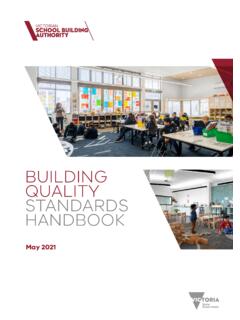Transcription of Guidance Note 2 Base Cost Estimation
1 Guidance Note 2 Base Cost Estimation March 2017 2 Cost Estimation Guidance Guidance Note 2 Base Cost Estimation Version March 2017 Commonwealth of Australia 2017 ISBN 978-1-925531-29-9 March 2017 / INFRASTRUCTURE 3180 Ownership of intellectual property rights in this publication Unless otherwise noted, copyright (and any other intellectual property rights, if any) in this publication is owned by the Commonwealth of Australia (referred to below as the Commonwealth). Disclaimer The material contained in this publication is made available on the understanding that the Commonwealth is not providing professional advice, and that users exercise their own skill and care with respect to its use, and seek independent advice if necessary. The Commonwealth makes no representations or warranties as to the contents or accuracy of the information contained in this publication. To the extent permitted by law, the Commonwealth disclaims liability to any person or organisation in respect of anything done, or omitted to be done, in reliance upon information contained in this publication.
2 Creative Commons licence With the exception of (a) the Coat of Arms; and (b) the Department of Infrastructure and Regional Development s photos and graphics, copyright in this publication is licensed under a Creative Commons Attribution Australia Licence. Creative Commons Attribution Australia Licence is a standard form licence agreement that allows you to copy, communicate and adapt this publication provided that you attribute the work to the Commonwealth and abide by the other licence terms. A summary of the licence terms is available from The full licence terms are available from This publication should be attributed in the following way: Commonwealth of Australia 2017. Use of the Coat of Arms The Department of the Prime Minister and Cabinet sets the terms under which the Coat of Arms is used. Please refer to the Department s Commonwealth Coat of Arms and Government Branding web page and in particular, the Commonwealth Coat of Arms - Information and Guidelines publication.
3 Contact us This publication is available in hard copy or PDF format. All other rights are reserved, including in relation to any Departmental logos or trade marks which may exist. For enquiries regarding the licence and any use of this publication, please contact: Director - Publishing and Communications Communications Branch Department of Infrastructure and Regional Development GPO Box 594 Canberra ACT 2601 Australia Email: Website: Cost Estimation Guidance Guidance Note 2 Base Cost Estimation Version March 2017 3 Document information Document Name Base Cost EstimationVersion and Date : March 2017 Prepared by Ben du Bois Approvals Approval and Authorisation Name Position Date Prepared by Ben du Bois Civil Engineer Change and Project Review Major Infrastructure Projects Office (MIPO) March 2017 Reviewed by Warren Fletcher Director Change and Project Review MIPO March 2017 Approved by Andrew Danks General Manager MIPO March 2017 Revision history Issue Date Revision Description March 2017 Initial release Before using any downloaded PDF version, or printed copy of the PDF version of this Guidance Note, readers should check the Department s website at the below URL to ensure that the version they are reading is current.
4 Note that the current version of the Department s Cost Estimation Guidance supersedes and replaces all previous cost Estimation Guidance published by the Department, other than that already included in current versions of the NOA and NPA (refer to section ). 4 Cost Estimation Guidance Guidance Note 2 Base Cost Estimation Version March 2017 Table of Contents 1: Introduction .. 6 : Context and Authority .. 6 : Related Guidance .. 6 : Availability and Version Control .. 7 : Objective and Scope of Guidance Note 2 .. 7 : Cost estimating challenges .. 8 : Definitions and Abbreviations .. 9 2: The Base Estimate .. 13 : Estimating methods .. 14 : Estimate Preparation .. 15 : Estimate Validation .. 16 : Construction Costs .. 17 : General .. 17 : Approaches to calculating Construction Costs for road projects .. 20 : Approaches to calculating Construction Costs for rail projects .. 20 : Client s Costs .. 21 3: Work Breakdown Structure .. 22 : Appropriate Level of Detail.
5 24 Cost Estimation Guidance Guidance Note 2 Base Cost Estimation Version March 2017 5 4: Project Cost Breakdown Template .. 26 : Differences between Road and Rail PCB templates .. 27 : WBS and PCB Element Content .. 27 : Client Costs .. 28 : Contractor s Direct Costs .. 29 : Contractor s Indirect Costs .. 29 : Client Supplied Materials and Services .. 29 5: Conclusion .. 33 Appendix GN2-1: Estimate Checklist and Design Maturity Matrix .. 34 Appendix GN2-2: Indirect Costs Checklist .. 35 Appendix GN2-3: Road and Rail PCB Templates .. 37 6 Cost Estimation Guidance Guidance Note 2 Base Cost Estimation Version March 2017 1: Introduction : Context and Authority This Guidance Note Base Cost Estimation is one component of the suite of documents that in aggregate, constitute the Department of Infrastructure and Regional Development (the Department) Cost Estimation Guidance . The base cost estimate will typically represent the greatest proportion of the cost of a project and is the starting point for the determination of contingency and escalation allowances.
6 Therefore it is crucial it be as accurate as possible because contingency and escalation estimates, together with the Base Cost Estimate, comprise the Project Outturn Costs at the various contingency levels. The Cost Estimation Guidance (the Guidance ) is referred to in Appendix B to the Notes on Administration for Land Transport Infrastructure Projects 2014-15 to 2018-19 (the NOA). The Guidance outlines the principles that must be followed by proponents in preparing cost estimates accompanying Project Proposal Reports, submitted in accordance with the NOA, which seek Australian Government funding for road and rail infrastructure projects. The NOA and the associated National Partnership Agreement on Land Transport Infrastructure Projects (NPA) are available at the following link: The Cost Estimation Guidance comprises the following key components: Overview; Guidance Note 1 (Project Scope); Guidance Note 2 (Base Cost Estimation ); Guidance Note 3A (Probabilistic Contingency Estimation ); Guidance Note 3B (Deterministic Contingency Estimation ); and Guidance Note 4 Outturn (Escalation) Cost Estimation .
7 In particular, this Guidance Note establishes the principles and framework for developing and preparing a project base cost estimate. Applying the principles and framework herein is intended to result in consistent, realistic, auditable, and appropriate project base cost estimates at each phase of the project life cycle. This Guidance Note should be read in the context of the Overview component of the Guidance and the specific requirements of the NOA. : Related Guidance Additional useful Guidance on cost Estimation practices, to the extent that they do not contradict the Guidance provided by the Department s Cost Estimation Guidance , may be found in individual agency cost Estimation Guidance or manuals, and in the Guidance provided by professional associations Project Management Institute, Australian Institute of Quantity Surveyors, Royal Institution of Quantity Surveyors, or AACE International. Cost Estimation Guidance Guidance Note 2 Base Cost Estimation Version March 2017 7 : Availability and Version Control The Cost Estimation Guidance is subject to periodic update, and hence is not available from the Department as a printed bound document.
8 Rather it is being published on the Department s website in PDF form, both as individual components, as well as a single consolidated document, that can either be read online or downloaded for subsequent use. A number of Excel spreadsheets and presentations accompany the various components of the Guidance to illustrate various aspects. The PDF components of the Guidance , and the accompanying spreadsheets and presentations are available from the Department s website at: , and are the current versions of the Guidance . The version date of each component of the Cost Estimation Guidance will be listed on the above webpage and will also appear as Appendix A Current Component Version Status Cost Estimation Guidance to the Cost Estimation Guidance Overview document. : Objective and Scope of Guidance Note 2 The objective of this Guidance Note is to foster an improvement in the way in which base estimates for infrastructure projects are prepared and presented.
9 This Guidance aims not to be prescriptive, but rather describes the methodology of how to develop a robust base cost estimate as well as providing broad descriptions of the typical elements of a base cost estimate for road and rail infrastructure projects. The Guidance covers the following topics: Definition of a Base Estimate - description of the key components of a base cost estimate; Base Estimate Preparation - Guidance on the methodology and tools used to develop a base estimate; Work Breakdown Structures and use of the Department s Project Cost Breakdown Template - Guidance on developing a Work Breakdown Structure and its relationship to the Department s Project Cost Breakdown and associated template; and Elements of a Base Cost Estimate - an overview and broad description of the components of a base estimate. This Guidance Note is premised mainly towards base cost Estimation practices expected to be utilised in major or high risk projects. However, the principles apply generally to projects of all sizes.
10 It applies only to Capital Cost Estimating and does not consider Operation and Maintenance (O&M) costs. While determination of O&M costs may be required for other financial and economic analyses, such as Cost Benefit Analysis, it does not form any part of the subject matter of this Guidance Note. It is expected that the primary users of this document will be jurisdiction ( Australian State and Territory) public sector organisations (Agencies), including Local Government Authorities and their contractors/consultants that have responsibility for delivering infrastructure projects. However, the 8 Cost Estimation Guidance Guidance Note 2 Base Cost Estimation Version March 2017 Guidance may also be relevant to academics, other contractors/consultants, other organisations and members of the public with an interest in major infrastructure projects. : Cost estimating challenges Developing a robust base estimate requires a well-defined scope, access to detailed documentation and historical data, and well-trained and experienced cost analysts.







